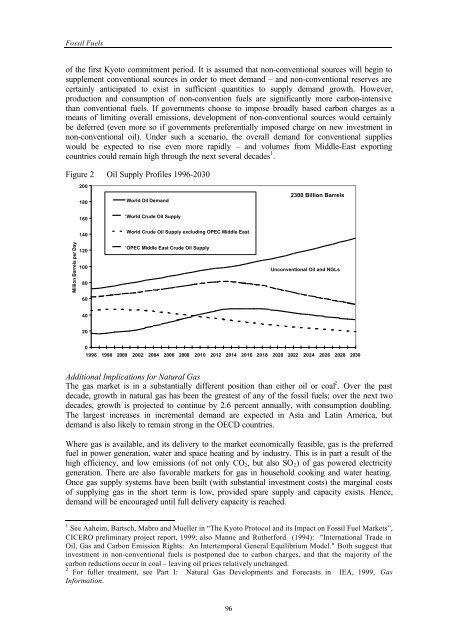sectoral economic costs and benefits of ghg mitigation - IPCC
sectoral economic costs and benefits of ghg mitigation - IPCC
sectoral economic costs and benefits of ghg mitigation - IPCC
Create successful ePaper yourself
Turn your PDF publications into a flip-book with our unique Google optimized e-Paper software.
Fossil Fuels<br />
<strong>of</strong> the first Kyoto commitment period. It is assumed that non-conventional sources will begin to<br />
supplement conventional sources in order to meet dem<strong>and</strong> – <strong>and</strong> non-conventional reserves are<br />
certainly anticipated to exist in sufficient quantities to supply dem<strong>and</strong> growth. However,<br />
production <strong>and</strong> consumption <strong>of</strong> non-convention fuels are significantly more carbon-intensive<br />
than conventional fuels. If governments choose to impose broadly based carbon charges as a<br />
means <strong>of</strong> limiting overall emissions, development <strong>of</strong> non-conventional sources would certainly<br />
be deferred (even more so if governments preferentially imposed charge on new investment in<br />
non-conventional oil). Under such a scenario, the overall dem<strong>and</strong> for conventional supplies<br />
would be expected to rise even more rapidly – <strong>and</strong> volumes from Middle-East exporting<br />
countries could remain high through the next several decades 1 .<br />
Figure 2 Oil Supply Pr<strong>of</strong>iles 1996-2030<br />
200<br />
180<br />
World Oil Dem<strong>and</strong><br />
2300 Billion Barrels<br />
160<br />
World Crude Oil Supply<br />
140<br />
World Crude Oil Supply excluding OPEC Middle East<br />
Million Barrels per Day<br />
120<br />
100<br />
80<br />
OPEC Middle East Crude Oil Supply<br />
Unconventional Oil <strong>and</strong> NGLs<br />
60<br />
40<br />
20<br />
0<br />
1996 1998 2000 2002 2004 2006 2008 2010 2012 2014 2016 2018 2020 2022 2024 2026 2028 2030<br />
Additional Implications for Natural Gas<br />
The gas market is in a substantially different position than either oil or coal 2 . Over the past<br />
decade, growth in natural gas has been the greatest <strong>of</strong> any <strong>of</strong> the fossil fuels; over the next two<br />
decades, growth is projected to continue by 2.6 percent annually, with consumption doubling.<br />
The largest increases in incremental dem<strong>and</strong> are expected in Asia <strong>and</strong> Latin America, but<br />
dem<strong>and</strong> is also likely to remain strong in the OECD countries.<br />
Where gas is available, <strong>and</strong> its delivery to the market <strong>economic</strong>ally feasible, gas is the preferred<br />
fuel in power generation, water <strong>and</strong> space heating <strong>and</strong> by industry. This is in part a result <strong>of</strong> the<br />
high efficiency, <strong>and</strong> low emissions (<strong>of</strong> not only CO 2 , but also SO 2 ) <strong>of</strong> gas powered electricity<br />
generation. There are also favorable markets for gas in household cooking <strong>and</strong> water heating.<br />
Once gas supply systems have been built (with substantial investment <strong>costs</strong>) the marginal <strong>costs</strong><br />
<strong>of</strong> supplying gas in the short term is low, provided spare supply <strong>and</strong> capacity exists. Hence,<br />
dem<strong>and</strong> will be encouraged until full delivery capacity is reached.<br />
1 See Aaheim, Bartsch, Mabro <strong>and</strong> Mueller in “The Kyoto Protocol <strong>and</strong> its Impact on Fossil Fuel Markets”,<br />
CICERO preliminary project report, 1999; also Manne <strong>and</strong> Rutherford (1994): "International Trade in<br />
Oil, Gas <strong>and</strong> Carbon Emission Rights: An Intertemporal General Equilibrium Model." Both suggest that<br />
investment in non-conventional fuels is postponed due to carbon charges, <strong>and</strong> that the majority <strong>of</strong> the<br />
carbon reductions occur in coal – leaving oil prices relatively unchanged.<br />
2 For fuller treatment, see Part I: Natural Gas Developments <strong>and</strong> Forecasts in IEA, 1999, Gas<br />
Information.<br />
96
















